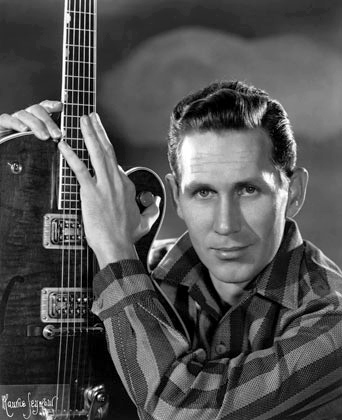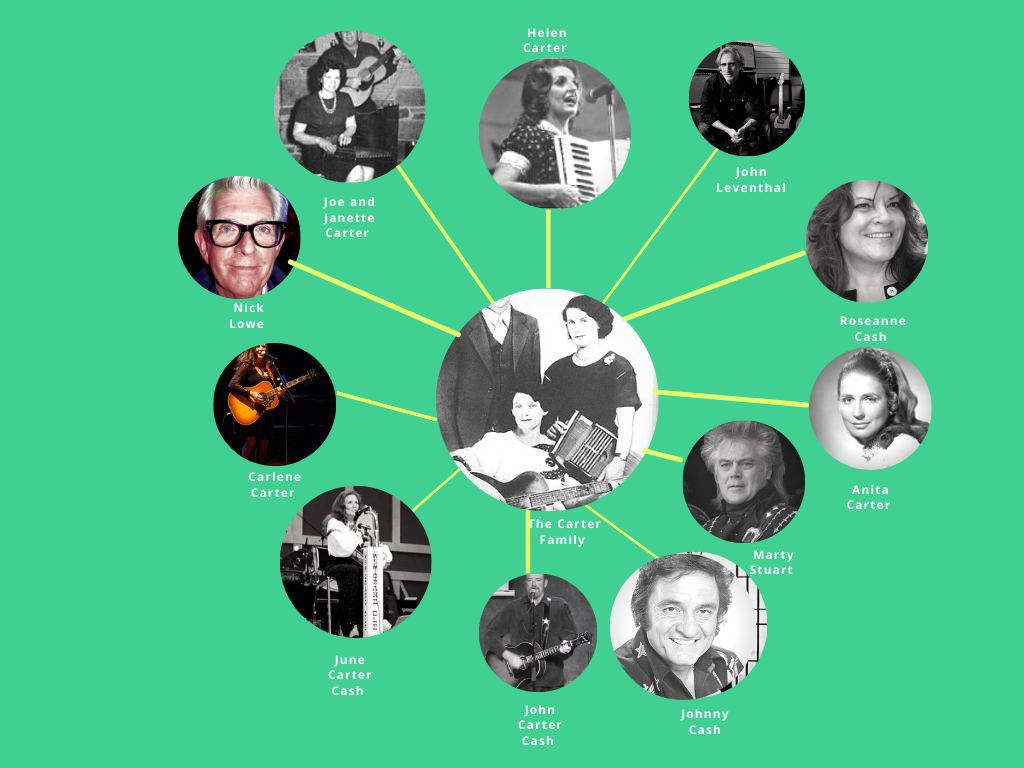
It was the summer of 1927 when Ralph Peer, a talent agent / record producer / recording engineer, pulled into Bristol, Tennessee. He was loaded down with recording equipment that he had been hauling around the south, searching for musicians to record. He had rented the third floor of the Taylor-Christian Hat and Glove Company building. There he hauled his recording equipment up three flights of stairs, where he setup his gear and got ready to meet, evaluate, and, to those he deemed talented, record. These recordings would be distributed on 78rpm records and would become one of the most important sessions in American music, known today as The Bristol Sessions.


For two weeks Ralph welcomed and recorded various artists. One of those was Jimmie Rodgers, who was featured in an earlier Musical Tree and would become one of the biggest artists of his time. The other act to emerge from The Bristol Sessions was a family who would help define the term Country Music and whose legacy and family members continue to influence modern music – from country, bluegrass, gospel, pop, even rock – today.

The Carter family was comprised of Sara Carter, her husband A.P. Carter, and A.P.’s sister-in-law Maybelle Carter. Born and raised in Maces Springs in southwest Virginia, The Carter Family gained local popularity through their mountain gospel music and what was referred to as shape note singing – a form of music that lends itself to congregational and social singing. Sara Carter sang lead vocal and played rhythm guitar or autoharp and Maybelle played lead guitar. A.P. sometimes sang harmony vocals, sometimes he didn’t perform at all.
The Carter Family made their first recordings at The Bristol Sessions on August 1, 1927. A.P. Carter had persuaded the group to make the trip when he had heard that Ralph Peer was going to be setting up recording sessions. Ralph and A.P. had corresponded earlier in the summer, but Ralph was still surprised when they showed up. Ralph described their appearance—A.P. showed up in overalls, and Sara and Maybelle looked like “country women from way back there – they were hillbillies”. Once Ralph heard Sara Carter’s voice he knew that he had to record them. Over two days they recorded six songs, with The Carter Family receiving $50 per song plus a half cent royalty for every copyrighted record sold.
On November 4, 1927, a 78 rpm single was released with the songs Wandering Boy and Poor Orphan Child. One year later the songs The Storms Are On The Ocean and Single Girl/Married Girl were released. All of these songs became very popular.
A.P. might have been labeled a hillbilly, but he could see the future in recorded music. By 1930 over 300,000 records had been sold in the United States and if an artist owned the copyright – which today we call songwriters credit – there was money to be made. A.P. traveled throughout Virginia, collecting and writing songs to record. Between 1930 and 1934 The Carter Family recorded and released an astounding 44 songs, including classics such as Worried Man’s Blues, Wildwood Flower, and Wabash Cannonball. In 1935 they recorded and released what is perhaps their most famous song, a song that has been recorded by hundreds of artists, Can The Circle Be Unbroken (sometimes titled Will The Circle Be Unbroken).
A.P. Carter may have been the first musician to recognize, embrace, and execute the business side of what would become the modern music industry. His foresight into the money that could be made by not just recording, but by copyrighting the material and getting royalties from sales, made him a pioneer at the time. While record sales weren’t tracked back then, The Carter Family’s records all sold very well, proof of the popularity of their music. Even more amazing is that this all took place during the Great Depression. Money may have been tight, but somehow folks had the means to buy The Carter Family records!
1936 saw a huge change in The Carter Family when A.P. and Sara Carter divorced. While details aren’t known about how or why they divorced (and we aren’t asking), what is known is shortly after the divorce Sara Carter married A.P.’s cousin. This would mark a huge change in The Carter Family – essentially they were now a 2-person outfit consisting of Sara and Maybelle.
In the late 1930’s Sara and Maybelle moved to Texas, where they were regular performers on radio shows. By the early 1940’s they began bringing their children into the act, and the seeds of an amazing Musical Tree were planted. Sara and A.P.’s children – Janette and Joe Carter – and Maybelle’s kids – Helen, Anita, and June – became regular performers. In 1944 Sara Carter and her new husband quit the group and moved to California. Maybelle continued to perform, under the name The Carter Sisters and Mother Maybelle. They continued to tour and appear on radio programs throughout the South.

It was around this time that The Carter Sisters and Mother Maybelle brought a new guitarist into their band. Chet Atkins was a young, pioneering guitarist making a name for himself. Joining the Carters helped launch his career, albeit with a hiccup along the way. The Grand Ole Opry had invited The Carter Sisters and Mother Maybelle to perform with the hope that the family would agree to become regular performers at the Opry. However, Chet Atkins played electric guitar – something still completely foreign to mainstream Country music at the time. The Grand Ole Opry said that the Carter’s could only appear if they left Chet Atkins out of the band. The Carter family was direct in their reply—no Chet, no Carter family. The Opry backed down and agreed to let them perform with Chet Atkins on electric guitar – the beginning of an 8 year run for The Carter Sisters and Mother Maybelle at The Grand Ole Opry.
Chet Atkins would go on to become one of the biggest influences on Country music guitarists, and Country music in general. Credit the Carters for being innovators by featuring an electric guitar player into their group, unheard of at the time but now as common as a sad Country song!
After the death of A.P. Carter in 1960, Sara and Maybelle reunited, the Carters went back to calling themselves The Carter Family, and they recorded an album and toured together during the huge folk revival. By this time the Carter family had expanded with multiple children performing in the band. After June Carter married Johnny Cash, he was accepted into the Carter Family and often featured them on his long running variety show on CBS (along with an incredibly diverse set of guest musicians, but that is a story for another blog).
If there ever was a built-in Musical Tree it is the Carter Family given the generations of offspring that performed not only as part of the family, but also had success on their own:
- A.P. and Sara’s son Joe and daughter Janette performed with the family band before continuing their parents’ legacy as a duo. Unfortunately that’s where the lineage for this side of the Carter family ends.
- Maybelle Carter and husband Ezra produced three wonderfully talented daughters – Helen, Anita and June. Helen’s influence on popular music include her singer-songwriter son Kenny Jones, while Anita’s marriage to Johnny Cash bandmate Bob Wootton brought the orbit of the Carter and Cash families closer together. However, it is June Carter who’s Musical Tree legacy is truly astounding.
- Prior to marrying Johnny Cash, June was married to Carl Smith. That marriage produced daughter Carlene Carter, who had success in the 1970’s and 80’s as both a country and new wave artist. She also would perform with the Carter Family throughout this time, and she had a hit single with the song I Fell in Love. It was during this period that Carlene married Nick Lowe, who had a big hit with the song Cruel To Be Kind.
- Prior to marrying June, Johnny Cash had been married to Vivian Liberto. They had four daughters, including daughters Cindy and Roseanne Cash. Roseanne has had a hugely successful career, scoring her first number one hit with the song Seven Year Ache. For a time Roseanne was married to John Leventhal, a songwriter / producer / musician who has contributed heavily to roots band music. For example, he arranged and played multiple instruments on the Marc Cohn hit Walking in Memphis. Roseanne has also has been a fierce proponent of her dad Johnny’s career and legacy.
- For a brief time Marty Stuart was part of the Carter legacy when he was the guitar player in Johnny’s band and married Johnny’s daughter Cindy Cash. The marriage only lasted five years.
- June and Johnny had one child, a son named John Carter Cash. John Carter Cash is a singer-songwriter but has had more success as a producer. He has produced albums for Sheryl Crow, Willie Nelson, Loretta Lynn, Elvis Costello, Emmylou Harris, and Vince Gill.
The Carter Family’s story has multiple layers that is impossible to capture in just one writing. I’ll have much more to share in my next edition of The Musical Tree, but for now I will leave you with this.
Johnny Cash would often take variations of The Carter Family on tour, with his wife June performing with The Carter Family as an opening act. June would also come out during Johnny’s set and perform a couple of duets such as the song Jackson with her husband. I was very fortunate to have seen them perform in the early 1970’s at the Eastman Theater in Rochester, New York. While I could not appreciate the musical significance at the time (I was barely a teenager, my grandma bailed on the ticket so my parents took me instead), I do have many positive memories from the concert. Chief among those was the beginning of Johnny Cash’s set. His band came out first and started playing a song. After a minute or two from the wings on the right side of the stage out strolled Johnny Cash, dressed in black. He quickly stepped to the microphone and said “Good evening everybody, I’m Johnny Cash”. My mother came out of her seat, squealing like a teenage girl, and the show was ON. 50 years later it is as clear as if it happened yesterday!
That’s it for this edition of The Musical Tree! Did you like this article? Leave a comment! Have a suggestion for a Musical Tree subject? Leave a comment! In the meantime keep it positive and play it loud!
Links to The Carter Family Playlists:

